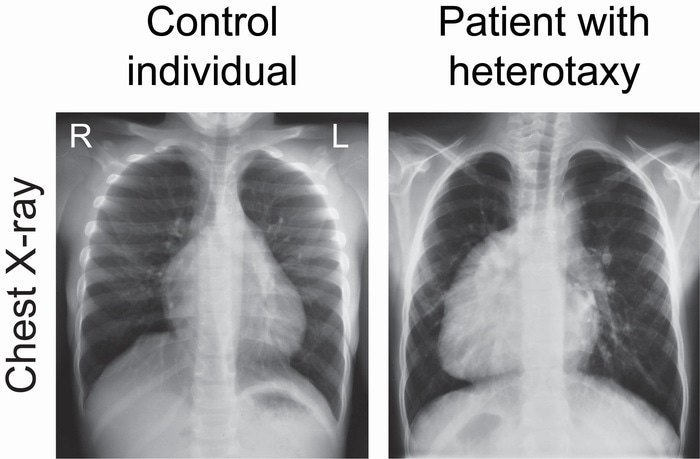A group of scientists headed by the Agency for Science, Technology and Research’s (A*STAR) Genome Institute of Singapore (GIS), in association with A*STAR’s Institute of Molecular and Cell Biology (IMCB) and Bioinformatics Institute (BII), and clinicians from six various countries recently identified a new gene.

Chest X-ray of a control individual (left), with his heart pointing to the left (L), while the chest X-ray of a patient with heterotaxy (right) revealed that his heart is inversely positioned pointing instead to the right (R). Image Credit: Laboratory of Human Genetics and Therapeutics, Genome Institute of Singapore (GIS), A*STAR, Singapore.
The gene, Ciliated Left-Right Organizer Metallopeptidase (CIROP), is vital for establishing appropriate left-right asymmetry at the time of vertebrate embryonic development. Babies having mutations in CIROP had their internal organs randomly positioned, resulting in serious birth defects consistent with heterotaxy.
The human body might look symmetrical as the left side appears to be a mirror image of the right side. However, this symmetry is only skin-deep as the internal organs are placed asymmetrically—the spleen and heart are found on the left side while the liver is present on the right side of the human body.
This is regulated by a set of genes—including PKD1L1, CIROP, DAND5, MMP21, and C1orf127—which functions during early embryonic development to allot each organ a stereotypical position. When this does not occur appropriately, babies are born with birth anomalies like congenital heart defects and misplacement of internal organs on the left-right axis.
Typically, these diseases arise once in every 10,000 births and are classified under syndromes of heterotaxy.
Evolutionary analysis of genomes from different vertebrate species revealed that CIROP, MMP21, PKD1L1, C1orf127, and DAND5 were seen in ancestral animals like fish and frogs, but absent in birds, reptiles, and some mammals like cetaceans. This pattern of gene disappearance at the time of evolution is associated with the loss of motile cilia in the transient organ that builds left-right patterning at the time of embryogenesis.
Our phylogenetic screen for genes that have disappeared in vertebrate species yielded important evolutionary insights into the development of left-right patterning. Our findings suggest that these five genes have only one function, which is to distinguish left from right. Active during a small window in the course of development, these genes may never be used again after birth.”
Bruno Reversade, Professor and Senior Group Leader, Laboratory of Human Genetics and Therapeutics, Genome Institute of Singapore
Bruno Reversade is also a professor at IMCB.
Dr. Emmanuelle Szenker-Ravi, Research Scientist from the Laboratory of Human Genetics and Therapeutics at GIS, and the study’s first author was struck by the fact that CIROP, a vital gene, was not characterized before.
CIROP’s incomplete annotation in the human genome prevented it from being used for diagnostic purposes via exome sequencing. We are thrilled that this is now remedied and will immediately benefit affected families.”
Dr Emmanuelle Szenker-Ravi, Study First Author and Research Scientist, Laboratory of Human Genetics and Therapeutics, Genome Institute of Singapore
“The study illustrates the power of Mendelian genetics which assigns gene functions and provides indisputable causality. Birth defects due to genetic mutations have devastating impact on both the children and their families. These findings will serve as the basis for research on potential therapies,” states Professor Patrick Tan, Executive Director of GIS.
Source:
Journal reference:
Szenker-Ravi, E., et al. (2021) Discovery of a genetic module essential for assigning left–right asymmetry in humans and ancestral vertebrates. Nature Genetics. doi.org/10.1038/s41588-021-00970-4.